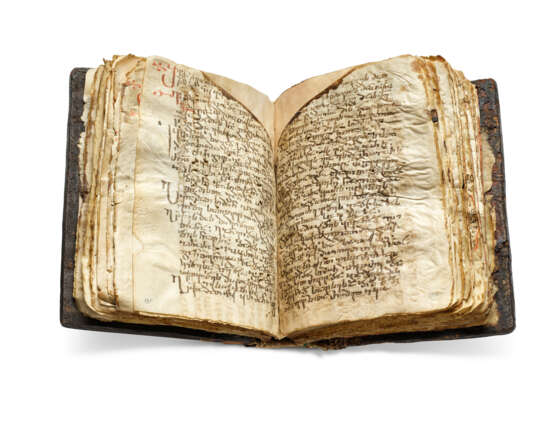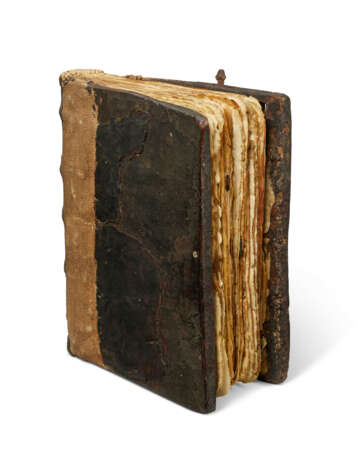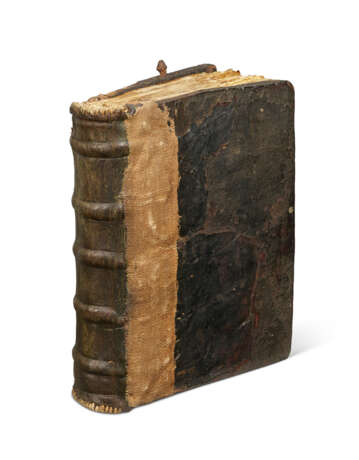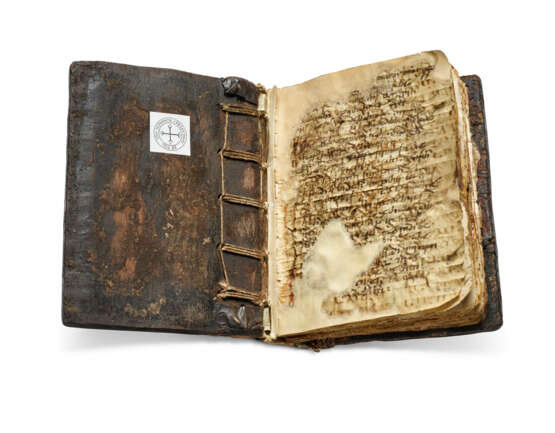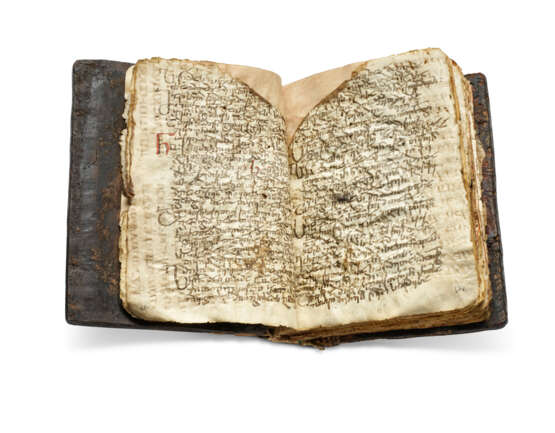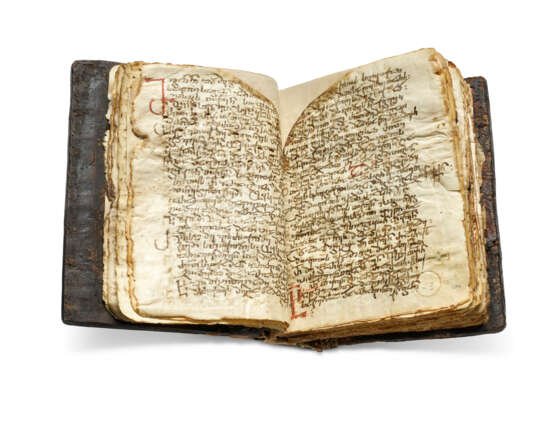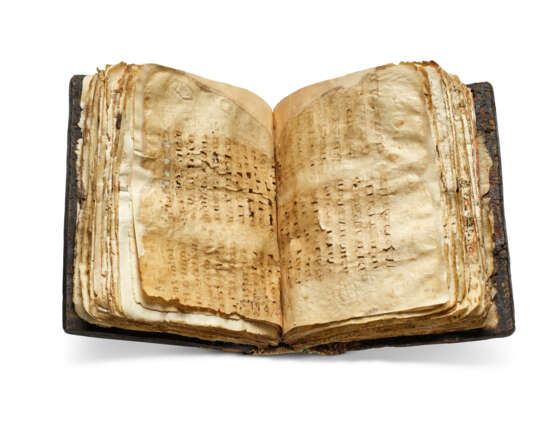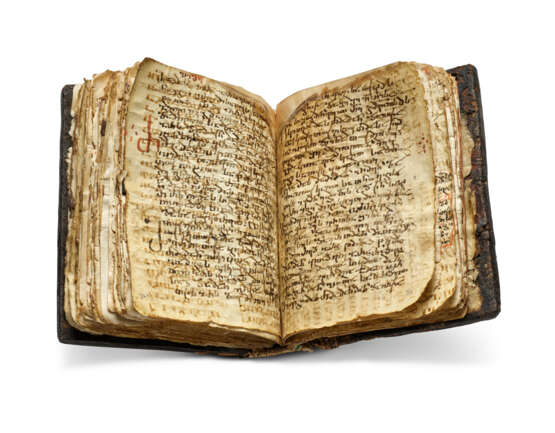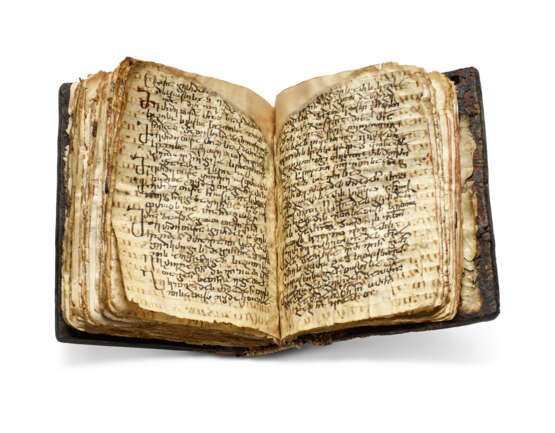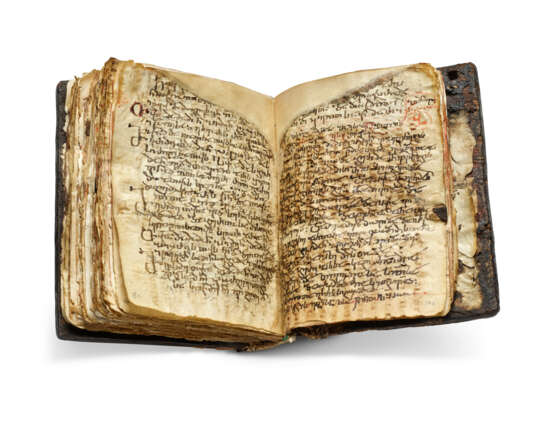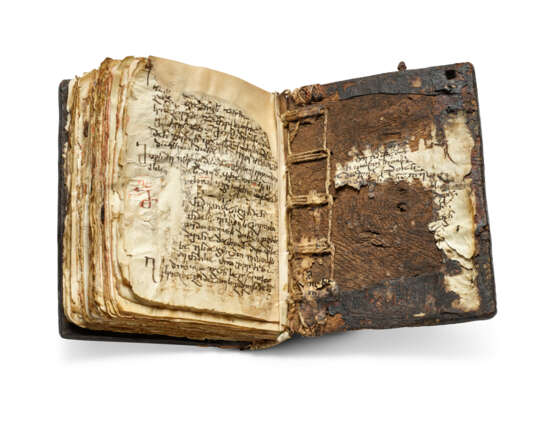ID 1214846
Lot 4 | The Codex Sinaiticus Rescriptus
Valeur estimée
£ 1 000 000 – 1 500 000
Codex Sinaiticus Rescriptus, in Christian-Palestinian Aramaic and Georgian, manuscript on vellum [Mt Sinai, Egypt, the underlying text late 5th-7th century, the overlying text 979]
One of the most important fragments to have come to auction of Christian Palestinian Aramaic, a Western Aramaic dialect used by the Melkite Christian community in Palestine and Transjordan between the 5th and 13th centuries and preserved only in a few inscriptions, palimpsests and manuscripts. The manuscript contains the earliest textual witnesses of the Gospels in the nearest dialect of Aramaic to that spoken by Jesus, composed within a living tradition based in the Holy Land. The palimpsest is overwritten with Georgian text written by the famed calligrapher, author, translator and bookbinder-monk John Zosimos, and survives here in his 10th-century binding from St Catherine’s Monastery in Sinai, the earliest known signed, dated and localisable binding.
A palimpsest: the manuscript as currently bound c.200 x 150mm, the leaves of the underlying texts sometimes turned at right angles, cropped and folded to create 70 leaves of overlying text, modern foliation in pencil, the underlying text (the palimpsests) comprising parts of six different manuscripts, c.140 x 190 - 310 x 200mm (originally c.310 x 230 - 320 x 230mm),11-25 lines (of originally 22-25) in two columns written in an exceptional Christian Palestinian Aramaic uncial, blind-ruled, 3 decorated crosses (2 of which are used for the book label of the Schøyen Collection); the overlying texts in Georgian, dated 979, 22-26 lines written in a single column of khutsuri ecclesiastical book script by John Zosimos, rubricated (a substantial fragment, edges frayed, the leaves flattened, cleaned and with modern repairs, yellowing and some ink erosion, underlying script very faded).
Binding:
Contemporary 10th-century black leather and linen over stout palm wooden boards from Mt Sinai, chain stitches on 5 sewing stations, signed and dated 979 by John Zosimos, fragments of pastedowns, leather and original binding thread survive (hole in bottom outer corner for a chain, iron nail with a conical head for a leather strap, restored, resewn and rebacked, lower cover with original leather over 19th-century wood, the cords fastened to the cover with small loops of thinner cord, headband coloured red, blue and yellow). For a full report and photographic documentation of the restoration of the binding and leaves by Don Baker and John Smart (three photographic albums accompany this lot), and comments on the binding restoration by Dr Mirjam Foot of the British Library in 1988, please contact the department. With a briefcase containing an envelope with binding fragments. Also included is a folder with fragments recovered from the restoration of the binding and another with the original sewing thread.
Provenance:
(1) The underlying 5th-, 6th-, and 7th-century Christian Palestinian Aramaic (CPA) manuscripts are likely from the monastery of the Great Laura at St Saba near Jerusalem (see below) and from the Monastery of St Catherine, Mt Sinai, perhaps in its library since the time of its foundation in the mid-6th century. They were brought together by:
(2) John Zosimos, or Ioane/Iovane Zosime, famed Georgian-Palestinian scribe, bookbinder, author, and translator: his extensive colophon on ff.66r-v and 69v: '[...] It has been written and finished and bound / this holy book on holy Sinai by the hand of Ioane, the very / sinful in the years of the Creation / according to Georgian reckoning 6583', i.e. 979 (f.66v). The conclusion of another short colophon is found on f.69: '[...] on holy Sinai [...] and in your holy prayer remember / me this very sinful Ioane Zosime'. Zosimos had been in the monastery of Great Laura at St Saba until 973, when he came to Mt Sinai, where he was active until at least 992. He is best known for his 'Praise and Exaltation of the Georgian Language', a mystic poem making heavy use of numerological symbolism and biblical allusions, in which he casts Georgian as an esoteric language, claiming for it a sacred role as the tongue to be used on Judgment Day. Zosimos reused considerable quantities of folios from discarded CPA manuscripts, some of which he had taken with him from St Saba: this is a prime example of his 'repurposing' (on Zosimos and his activity, see M. Tarchnišvili and J. Assfalg, Geschichte der kirchlichen georgischen Literatur auf Grund des ersten Bandes der georgischen Literaturgeschichte von K. Kekelidze, 1955, pp.109-114; S. Rapp, Studies In Medieval Georgian Historiography: Early Texts And Eurasian Contexts, 2003, pp.437-438; and Brock, 2012, pp.8-12).
The present fragment is a substantial part of what is now known as Codex Sinaiticus Rescriptus (or Codex Sinaiticus Zosimi Rescriptus by Desreumeux, see Literature), studied at Sinai by the Georgian scholar A. Tsagareli in 1883 (his Tsagareli 81, see Tsagareli, 1888, p.233, no 81). The other substantial section of the manuscript is now St Petersburg, National Library of Russia, Syr. 16 (a shelf number which also includes part of Sinai, Georg. 34, written by Zosimos at St Saba in 969 and brought with him to St Catherine's). The CPA undertexts of the St Petersburg folios were published by J.P.N. Land in the fourth volume of his Anecdota Syriaca (1875), but are now available in a comprehensive edition by C. Müller-Kessler and M. Sokoloff in their Corpus of Christian Palestinian Aramaic. The composite, repurposed CPA manuscripts used by Zosimos in Tsagareli 81, Georg. 34, etc. have been traced and identified by scholars in a number of institutions and collections, among these: Princeton, Garrett MS 24; Göttingen, Syr. 17, 19, 23, 25; and Schøyen MS 36, a leaf sold at Christie's on 10 July 2019, lot 407, for £35,000, which never belonged to Tsagareli 81 (as it is partially overwritten in Syriac or without overtext), but shares a parent CPA Gospel manuscript with other leaves used by Zosimos in Tsagareli 81.
A detailed reconstruction of the original constituent parts of CPA texts under Georgian manuscripts, including Tsagareli 81, can be found in Müller-Kessler, 2022, pp.24-49.
While the first part of Codex Sinaiticus Rescriptus was brought to St Petersburg, by the end of the 19th century the second part, bound in its 10th-century Sinai binding, was in the collections of:
(2) Dr Friedrich Grote (1861-1922), German manuscript collector who owned an impressive collection of manuscripts and fragments with a Sinaitic provenance. Several of his Syriac, Arabic, CPA and Georgian manuscripts are now in major libraries and collections: the Vatican library, the BnF, the British Library, among others. According to Gregor Peradze (Peradze, 1933, p.191), the manuscript was still in the collection of Grote's widow in Berlin in 1929. By 1937, though, it had been sold to:
(3) Erik von Scherling (1907-1956), Rotulus, IV (1937), no 1900, pp.30-32.
(4) Sotheby’s 12 April 1954, lot 302: 'The Property of D. MacLaren, Esq.', purchased by:
(5) Dr Otto Fisher (1881-1961), of Detroit.
(6) H.P. Kraus, ‘Monumenta Codicum Manuscriptorum’ (1974), no 1.
(7) H.P. Kraus cat. 165 (1983), no 28.
(8) Schøyen Collection, MS 35.
Text and script:
There are three principal locations which have brought to light CPA manuscripts in Egypt (almost exclusively palimpsests): St Catherine’s Monastery on Mt Sinai; the Wadi El Natrun and the Cairo Genizah. An important Mt Sinai codex is the so-called Codex Climaci Rescriptus: it was acquired by the Biblical scholars and twins Agnes Smith Lewis (1842-1926) and Margaret Dunlop Gibson (1843-1920) in three stages between 1895 and 1906 before entering the collections of Westminster College, Cambridge (now in private ownership in the US; another single leaf from that codex, which contains Acts 21:14-25, forms Cod. Ms. Syr. 637 of the Mingana Collection, Birmingham).
The script of Codex Sinaiticus Rescriptus (CSR) is almost identical to that of Codex Climaci Rescriptus (CCR), and both are considered the finest and earliest specimens of Christian-Palestinian Aramaic uncial extant. The language is otherwise represented in only a small scattering of fragments, all of which are in major institutions: a section of a Vatican manuscript (MS. Sir 623) with readings from Exodus; a handful of fragments from the Cairo Genizah; a few fragments from Khirbet Mird excavations in the 1950s (now Rockefeller Museum, Jerusalem; three fragments still in the library of St Catherine’s, Sinai (all 11th century); two leaves in the British Library (BL Add. 14450 and Or.1080.4.65a); a fragment in the Louvre, Paris; five leaves at the Bodleian, Oxford (MS Heb. e. 73 ff.42-3; MS Heb. b. 13, f.13; MS Syr. d. 32; 33 and Syr. c. 4); a small fragment in Philadelphia (Penn. E 16507r); and two leaves in St Petersburg (Greek, ms. 119 and Antonin, Ebr. B 958v).
CSR was extensively described as early as 1906 by Hugo Duensing and again by him in 1944 and 1955; more recently in part by Alain Desreumaux (Desreumaux, 1997); and most comprehensively by Christa Müller-Kessler and Michael Sokoloff (Müller-Kessler and Sokoloff, 1997-1999).
Since leaves from different manuscripts were reused by Johannes Zosimos in the 10th century for his Georgian text, and, as with other early palimpsests, these were sometimes turned at right angles and folded to create the bifolia of the smaller manuscript, it is impractical to list the content of the underlying texts according to their current foliation in the codex. The palimpsest texts written in CPA comprise (the CSR classifications are those used by Müller-Kessler and Sokoloff):
Text 1 (CSR b)
The text is from an Old Jerusalem Lectionary and includes Psalms 26:7; Proverbs 1:15-19; Jeremiah 1:11-17; and Daniel 3:24-37. Other fragments from this CPA manuscript are St Petersburg, National Library of Russia, Syr.16 and Sinai, Georg. NF 19, 71. The single lections follow the same sequence as in Codex Climaci Rescriptus: surviving folios in that manuscript are missing in this manuscript and the other way around. The script is larger and points to an earlier dating, perhaps as early as the 5th century (see Müller-Kessler, 2014, p.270).
Text 2 (CSR c)
The text is from a Gospel Lectionary with 23 lines to a column and references in the margin to other synoptic Gospels, following the Ammonian section numbers and references to Eusebian canon tables. The script is in the common early style similar to the previous text. The text comprises: Mark 4:7-9, 11-13, 16-17; 8:6-22; 9:38-10:3; Luke 1:16-30, 50-80; 2:1-7; 9:7-19, 32-44; 10:12-24; 19:48-20:14 and John 7:33-47. Other fragments from this manuscript are at St Petersburg, National Library of Russia, Syr.16 and Sinai, St Catherine, Sp.16.
Text 3 (CSR e)
The text is from a Gospel Lectionary with 24 lines to a column, where the end of a verse is indicated by three dots. This Lectionary is subdivided into lections with liturgical commemorations that sometimes follow the Old Jerusalem Armenian Lectionary. Next to the columns the synoptic Gospels are indicated roughly. The text comprises: Matthew 23:4-17; 23:29-24:18; 24:45-25:11; 27:7-22; Mark 5:26-28, 32-29; 6:35-50; 7:6-21; 9:2-14; 10:44-46, 51-52; 12:35-13:2; and 14:72-15:31. Other fragments from this manuscript are at St Petersburg, National Library of Russia, Syr.16; Sinai, Georg. NF 19 and St Catherine, Sp.7.
Text 4 (CSR i)
The text of this manuscript contains an Aramaic translation of Cyril of Jerusalem's (c.313-386), Catechetical Lectures, several of which are the earliest or only witnesses in this dialect, based on an early unattested Greek witness. It comprises: Procatechesis 9 - 11; Books III:8-10; IV:1-2; V:7-8; VI:3-4, 24-26; VII:6-9; VIII:3-5; X:18-19; XII:13-15, 30-32; XIII:31-33; XIV:21-22; XV:20-22; XVI:26-28; XVII:12-15, 19-21. Other leaves from this CPA manuscript are at St Petersburg, National Library of Russia, Syr.16 (several of the St Petersburg fragments join fragments in this manuscript); Sinai, Georg. NF 19 (Hymnary), 71 (Gospel Lections); 8 recently published fragments in St Catherine's Monastery (see below); and Schøyen Collection MS 37.
For the most recent edition of this CPA manuscript see Müller-Kessler and M. Sokoloff, 1999, with recent additions studied in Müller-Kessler, 2021, pp.25-66.
Text 5 (CSR j)
These fragments are from a CPA manuscript of 22 lines in two columns containing unidentified homilies, apparently comparing the Church to a threshing floor, wine-press and oil-press. Its sister fragment at St Petersburg contains an earlier version of the beginning of a homily on the prodigal son attributed to John Chrysostom. Duensing and Desreumaux noted the following biblical quotations: Matthew 5: 15 and 6:32-33; Romans 8:26-27 and 1 Corinthians 12:4.
Text 6 (CSR k)
These fragments belong to an unidentified manuscript of 22 lines and datable to the 7th century, containing many paraphrased citations from the Old and New Testament. Other fragments are in St Petersburg and Sinai. Duensing and Desremeaux note the following biblical citations: Genesis 49:11; Exodus 25:40; Numbers 26:10; Psalms 68:32; Isaiah 63:1-2; and Matthew 3:12-13.
The overlying text is written in a Georgian ecclesiastical book script by John Zosimos. The lacunae in the Georgian text in this manuscript largely correspond to what is present in St Petersburg, National Library of Russia, Syr.16, and vice versa, according to the table of contents on f.50 of the St Petersburg fragment. The reconstruction of the Georgian text is described by Van Esbroeck, 1975, pp.63-75. Our fragment contains Gospel pericopes (readings for various Sundays and feast days) and two early monastic texts: the Apophthegmata about Apa Pimen and the the Letter of Arsenios. The Apophthegmata ('sayings') consist of short anecdotes concerning the earliest Egyptian monks: they exist in many redactions and translations and exerted a powerful influence on later monastic literature. In this case, we have stories and sayings of Father Pimen, who played a major role in ancient monasticism. The Letter of Arsenios, ascribed to the noted hermit Arsenios who lived in the 4th and 5th centuries in Lower Egypt, contains ascetical instructions for monks (see Garitte, 1954). Both texts are extant only in Georgian; the Pimen is apparently the sole extant source for this text; the Arsenios is one of three manuscripts known, and is the only dated one, and probably the oldest of the three.
Literature
Brock, S., 'Ktabe Mpassqe: Dismembered and Reconstituted Syriac and Christian-Palestinian Aramaic Manuscripts: Some Examples, Ancient and Modern,' Hugoye 15, 2012, pp.7-20.
Brock, S., 'Sinai: A Meeting Point of Georgian with Syriac and Christian Palestinian Aramaic,' The Caucasus between East & West, 2012, pp.482-494.
Desreumaux, A., ‘Codex sinaiticus Zosimi rescriptus; Description codicoligique de feuillets araméens melkites des manuscrits Schøyen 35, 36 et 37’, Histoire du Texte Biblique 3, 1997.
Desreumaux, A., ‘L’apport des palimpsestes araméens, Christo-palestiniens. Le cas du Codex Sinaiticus Zosimi rescriptus et du Codex Climaci rescriptus’, Palimpsestes et éditions de textes, Les textes littéraires. Actes du colloque tenu à Louvain-la-Neuve, September 2003, 2009, 201-11.
Duensing, H.D., Christlich-palästinisch-aramäische Texte und Fragmente, 1906.
Duensing, H.D., Neue christlich-palästinische-aramäische Fragmente, 1944.
Duensing, H.D., Nachlese christlich-palästinisch aramäischer Fragmente, 1955.
Garitte, G., Catalogue des manuscrits géorgiens littéraires du Mont Sinaï, 1954.
Müller-Kessler C., 'Codex Sinaiticus Rescriptus (CSRG/O/P/S): A Collection of Christian Palestinian Aramaic Manuscripts,' Le Muséon 127, 2014, pp.263-309.
Müller-Kessler C., 'Neue Palimpsestfragmente zu den Katechesen des Cyrill von Jerusalem im Codex Sinaiticus rescriptus (Georg. NF 19,71) mit einem zweiten Textzeugen (Syr. NF 11) aus dem Fundus des St. Katherinenklosters,' Oriens Christianus 104, 2021, pp.25-66.
Müller-Kessler C., 'Piecing together Christian Palestinian Aramaic Texts under Georgian Manuscripts', Digital Kartvelology 1, 2022, pp.24-49.
Müller-Kessler C., and M. Sokoloff, Corpus of Christian Palestinian Aramaic, I, IIA, IIB and V, 1997-1999.
Müller-Kessler C., and M. Sokoloff, The Catechism of Cyril of Jerusalem in the Christian Palestinian Aramaic Version, 1999.
Peradze, G., 'Die alt-christliche Literatur in der georgischen Überlieferung,' Oriens Christianus 30, 1933.
Tsagareli, Monuments of Georgian Antiquity in the Holy Land and on Sinai, Orthodox Palestinian Collection 4/1, 1888, p.233, no 81.
Van Esbroeck, M. V. E., 'Les manuscrits de Jean Zosime Sin. 34 et Tsagareli 81,' Bedi Kartlisa 39, 1975, pp.63-75.
Exhibited
Conference of European National Librarians, Oslo, September 1994.
XVI Congress of the International Organization for the study of the Old Testament. Library of Law Faculty, University of Oslo, 29 July - 7 August 1998.
| Lieu d'origine: | Egypte, Afrique |
|---|---|
| Catégorie maison de vente aux enchères: | Manuscrits médiévaux et de la Renaissance, Livres et manuscrits |
| Lieu d'origine: | Egypte, Afrique |
|---|---|
| Catégorie maison de vente aux enchères: | Manuscrits médiévaux et de la Renaissance, Livres et manuscrits |
| Adresse de l'enchère |
CHRISTIE'S 8 King Street, St. James's SW1Y 6QT London Royaume-Uni | |
|---|---|---|
| Aperçu |
| |
| Téléphone | +44 (0)20 7839 9060 | |
| Commission | see on Website | |
| Conditions d'utilisation | Conditions d'utilisation |
